Paul Anka Turns 80: The Life and Legacy of the Famed Canadian Crooner, In His Own Words

Paul Anka as he appeared in a 2013 cover story for Zoomer Magazine. Photography: Gabor Jurina
Paul Anka is all about making memories.
Sure, “Making Memories” is both the title of the Canadian crooner’s upcoming album — and its first single — but it’s also something Anka, who turns 80 on July 30, has been doing since his youth, when he’d sneak off to watch singers like Sammy Davis Jr. perform.
“You’ve made memories for me for a long, long time and I appreciate that,” Anka said in a video to fans posted to his social media accounts, where he’s been counting down to his birthday. “And I thank all of you for doing it your way and helping me my way. Take care everybody.”
Of course, Anka’s storied career spans a whopping 64 years — dating back to when he penned the chart-topping hit “Diana” at the tender age of 16. From there, Anka never looked back, earning teen idol status as screaming young women packed concerts and clamoured to get closer to the singing sensation from the Great White North.
Anka, though, understood the importance of diversifying his career, aware that his teen idol status wouldn’t last forever — especially once four mopped-topped Liverpudlian singers landed in America in 1964.
But Anka pivoted, recording and performing his own tunes while also penning hit songs for other artists — most famously “My Way” for Frank Sinatra, “She’s a Lady” for Tom Jones and the now-iconic theme song for The Tonight Show Starring Johnny Carson, among others.
In 2013, Anka sat down with Zoomer for an interview and cover shoot and reminisced about his early life, the height of fame, hanging out with Frank Sinatra and the Rat Pack, writing his most famous songs and the difference between teen idol status when he was young and today.
And when it comes to his longevity, he noted how watching the Rat Pack’s excessive drinking and smoking inspired him to take the opposite path and nurture his health:
“I subscribed to the fact that what I did back then [could] come back and haunt me. So I eat a certain way, I exercise, I don’t drink heavy liquor, I’m not a smoker. I rest my voice. Little things that enable me to over-punch my weight.”
And we’re glad he did. So to celebrate Paul Anka turning 80, we revisit that Zoomer cover story and photo shoot with the entertainment legend.
Put Your Head on My Shoulder: Paul Anka Talks Life, Longevity and Music
A FLURRY OF WOMEN clutching cellophane-wrapped roses hurries into Toronto’s Sony Centre, shielding their dresses from the rain on a dreary St. Valentine’s evening. Inside, an expectant buzz permeates the crowd as horns, strings, percussion and pianist take the stage. Then, without warning, the room goes black. A spotlight slices through the darkness and hits the back of the auditorium. The band bursts into the first melody and, through the crowd, those familiar lyrics ring: “I’m so young and you’re so old. This, my darling, I’ve been told …”
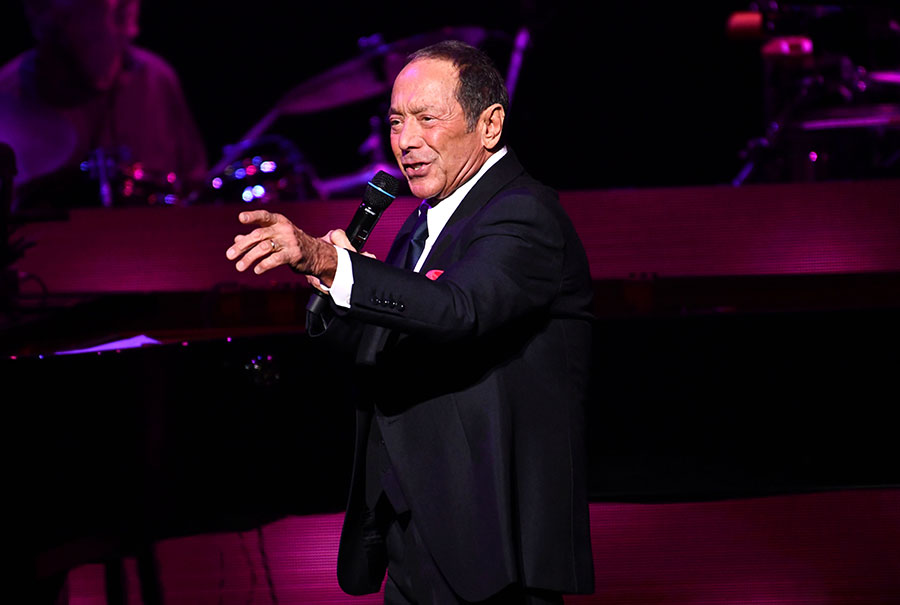
The throng of screaming female fans nearly overwhelms Paul Anka, 71, when he appears through a gauntlet of outstretched arms in a slim black suit and tie, all the while not missing a note.
My initial thought as I observed the mob scene: is this actually happening? The last Paul Anka single to top the U.S. Billboard charts, “(You’re) Having My Baby,” came in 1974, and his last top 10 tune, “Times of Your Life,” in 1975. Even his adult contemporary chart hit, “Hold Me ’Til the Mornin’ Comes,” peaked in 1983. Yet it’s wholly clear during his concert that he’s not some washed-up former idol clinging to fame by offering an early bird special for dinner and a show. Anka sings, swings, dances and improvises, owning the Toronto crowd for more than two hours — with no intermission. Women rush to offer roses or abandon their dates to embrace him in the aisles. Paul Anka 1, Cupid 0.
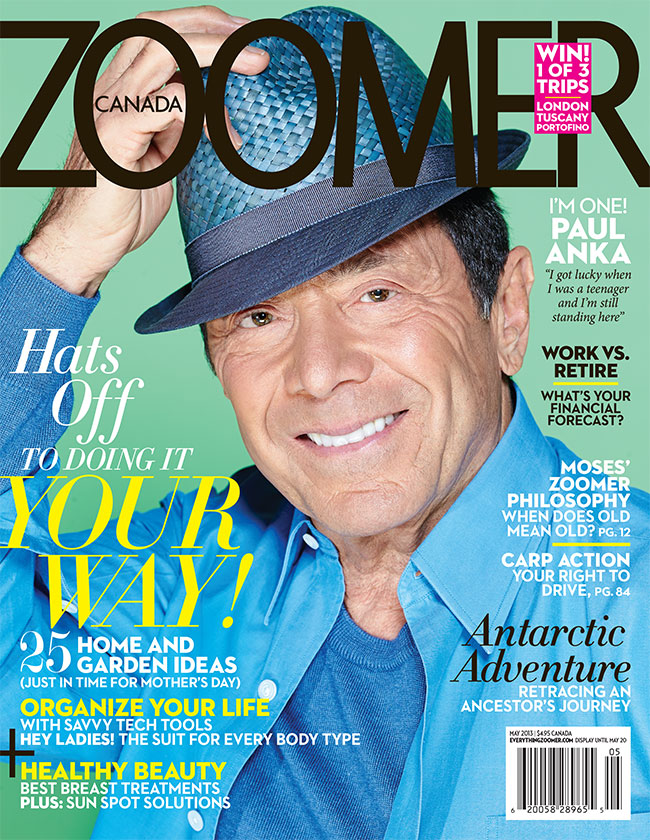
“[Women] show up while you’re singing, running up to you as if you’re not,” he laughs when I ask him about his devoted female fans. “They’ve got old pictures in your face of when they were 18. They’ve got memorabilia that you’ve signed, all over the world.”
A few days after the show, Anka and I walked the hallways of a downtown Toronto photography studio. When I told him how much I enjoyed his concert, it struck me that he genuinely appeared to appreciate the sentiment — never mind that it was coming from someone too young to have heard his chart-topping singles when radio disc jockeys had them on heavy rotation. It mattered what this audience member thought. And that, I realized, is the key.
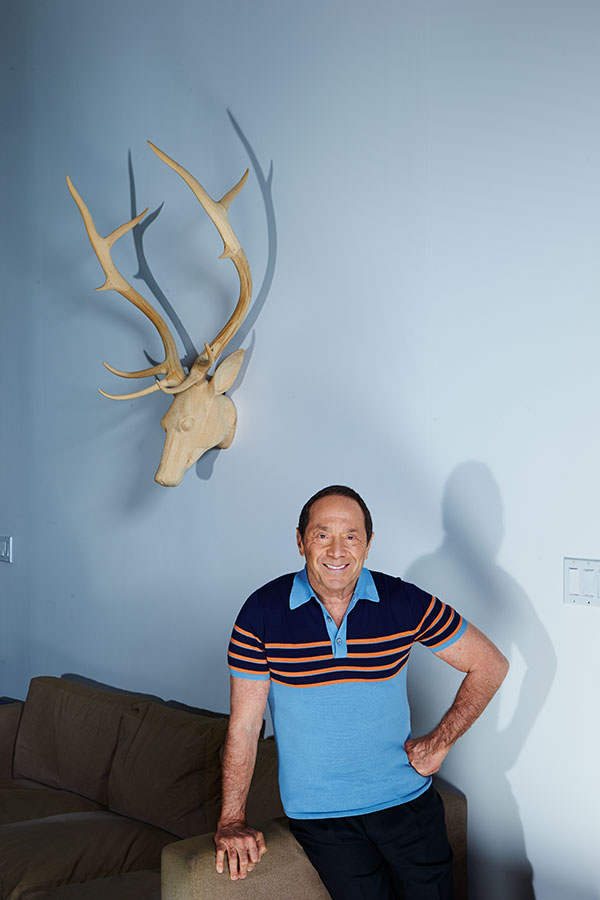
For Anka, success is measured more by the credibility he maintains among his fan base than by Billboard’s Top 40. It’s what motivates him when working on new projects, like his album, Duets, and a long-awaited autobiography, My Way: An Autobiography, both due out in April. It’s also the reason his concerts remain a hot ticket. On stage at the show, Anka takes a breather to acknowledge his band. As the first notes of the next song hit, he turns to the crowd: “Put your arms around each other and hang on. You’re going into orbit.”
By the end of the show, Anka stands on stage, legs apart, fists firmly planted on his hips, soaking the adulation in. He evokes an image of Peter Pan: ageless and brimming with the joy of performing, having honed the tricks he learned from hanging with the pirates and lost boys of Las Vegas — the Never-Never Land where adults flee to feel like kids again.
Becoming Paul Anka
In an age of American Idol and 24-hour news cycles, where celebrity is created and torn down quicker than you can say Clay Aiken, Anka’s evolution from teen idol to Vegas headliner to music legend over the past 55 years proves that much more remarkable.
Born in 1941 in Ottawa, by age 12 Anka had caught the show business bug and decided that music was his ticket out of town. When he wasn’t sneaking off to watch singers like Sammy Davis Jr. perform across the river in Quebec, or crooning with his first group — the Bobby Soxers — Anka spent much of his early teens in his parents’ basement, writing.
It started with a job as a cub reporter for the Ottawa Citizen. His attention soon turned to poetry and then to crafting lyrics and working out melodies by studying Shakespeare’s method of rhythm and rhyme.
“People always respect Shakespeare,” Anka explains, “and the play’s the thing. I stayed very viable as a writer, and my cred stayed very real. It separated me from all those other kids I grew up with.”
Initially, Anka’s father, Andy, wasn’t thrilled about his son’s show biz ambition.
“What did [he] know? I’m a kid from Ottawa,” Anka laughs. “You’re going to be a lawyer like your uncle.”
Anka’s mother, Camy, however, nurtured the dreams of stardom that danced in his head.
“His mother is like [his] internal sunshine,” says David Dalton, a founding editor of Rolling Stone magazine and co-writer of Anka’s autobiography. “If your mother loves you to the extent that his did, it’s like you’re invincible.”
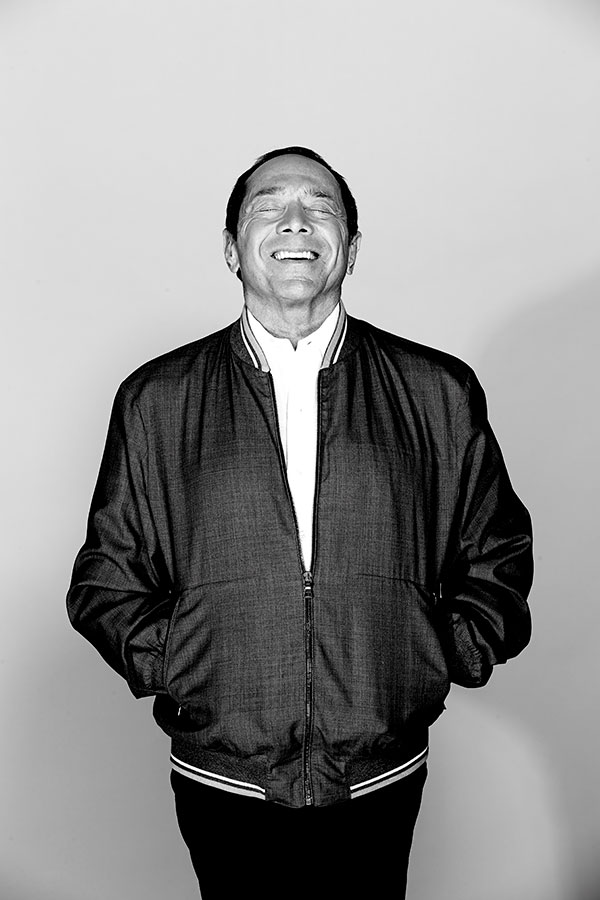
Regardless of Anka’s blossoming talents, the music industry’s radar wasn’t exactly honed in on Ottawa in the 1950s. YouTube was non-existent; reality TV judge Simon Cowell wouldn’t make his first singing hopeful cry for 50 years. Instead, Anka heard opportunity knocking in the most unlikely of places: the grocery store.
At 15, he was working part-time at the local IGA when the Campbell Soup Company promoted a contest awarding the person who collected the most soup can labels a recording session in New York City. Familiar with the customers who bought the brand, Anka cleverly arranged to collect all of their labels in addition to his own. He won.
The song he recorded wasn’t a hit, but it gave him that taste of showbiz he’d been craving. A year later, in 1957, he made his way back to the Big Apple to pitch another tune — one he wrote about a 19-year-old girl from church named Diana.
Paired with ABC-Paramount Records producer Don Costa — whose understanding of Anka’s brand of teenage ballad Dalton calls “a perfect match” — “Diana” shot to No. 1 in Canada, the U.S. and overseas, landing the 16-year-old on both Dick Clark’s American Bandstand and The Ed Sullivan Show that same year. He also went on the road, touring the U.S. with the likes of Chuck Berry, Fats Domino, the Everly Brothers and Buddy Holly.
He embarked on his first European tour in 1958 and, in June 1960, at the age of 18, he became the youngest performer to ever headline New York’s iconic Copacabana nightclub — made famous by his idols Frank Sinatra and the Rat Pack — lending him a measure of respect that proved crucial when he started playing Vegas shortly after.
“He’s really an incredible phenomenon,” Dalton says. “In a certain sense, he’s like the James Dean of pop music. Basically, he’s the one that inspired teenagers to do it themselves. I think he created the teen dream that’s at the very core of pop music.”
Anka however, offers a more modest perspective of his early success. “I got lucky when I was [a teenager] and I’m still standing here,” he says. “Every decade, there’s one of us [teen idols] that pops.”
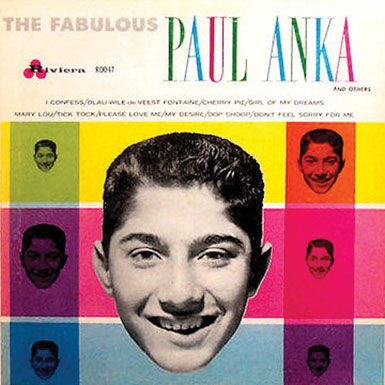
The current teen idol du jour — Justin Bieber — is, coincidentally, also a Canadian kid known for his boyish good looks, catchy tunes and well-coiffed hair. While the job description hasn’t changed much, other aspects have, starting with the pay cheque.
“Back then with the No. 1 record in the country, I earned 300 bucks and I figured I owned the world,” Anka laughs. “You see the money these kids are making today — it’s insane.”
The Beatles Invade and Anka Pivots
Bieber’s talent is obvious but, Anka wonders, “Is there going to be any longevity there? Is there going to be a foundation that takes him to the next level?”
A fair question, considering Anka himself arrived at a similar crossroads in the 1960s. Part of it had to do with his desire to “graduate” to Copacabana-style nightclubs and part of it came courtesy of four mop-topped lads from Liverpool who, like a meteor out of the sky, hit America.
The Beatles touched down in New York City on Feb. 7, 1964, and before you could say “John, Paul, George and Ringo,” teen idols from Frankie Avalon to Fabian became American pop culture casualties. In a bitter irony, Anka met the Fab Four in Europe before the British Invasion, returning to the U.S. raving about the then-unknown band. Now, it was the Beatles bringing squealing teenage girls to tears on the same Ed Sullivan Show stage he first graced just seven years earlier.
“The ’50s were great. The ’60s sucked,” he laughs when thinking back.
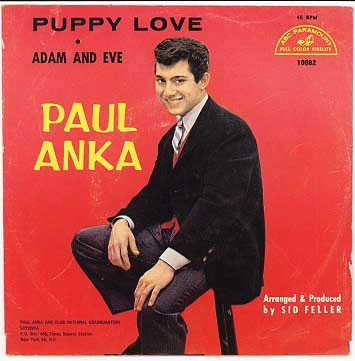
After a string of chart-toppers in the late 1950s, his only top 10 hits on U.S. radio in the 1960s were “Puppy Love” (No. 2 in 1960) and “Dance On Little Girl” (No. 10 in 1961). By 1962, he’d switched record companies and, in a move that Dalton deems “absolutely revolutionary,” bought his entire catalogue back from ABC-Paramount.
“If you own the masters, you own those songs lock, stock and barrel. He made money every time somebody bought a record [or] played it … and I’m sure that sustained him through the shallow parts of his career.”
Anka swam against the tide of the invasion, taking his act across the pond to Europe. Since the age of 17 he’d enjoyed success touring outside of North America, proving especially popular in Italy where — thanks in part to his ability to handle the language like a local, and the vowel at the end of his surname — many fans mistook his Lebanese heritage for Italian. Riding the momentum of the 1962 Italian chart-topper, “Ogni Giorno” (“Every Day”) and the popular “Piangerò per te” (“Crying in the Wind”) from 1963, Anka released the multi-million selling “Ogni Volta” in 1964.
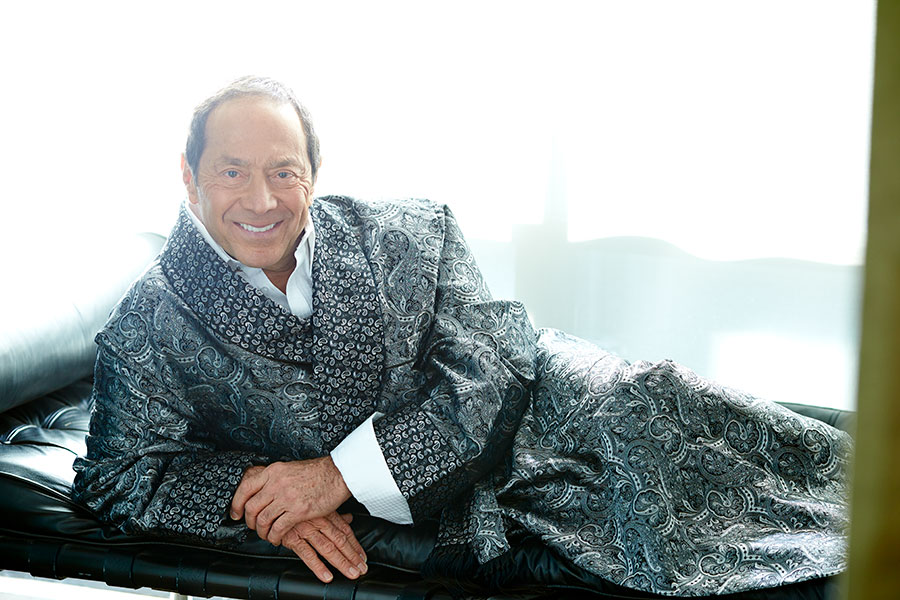
When he’d travel back to America throughout the decade, Anka set up shop on the neon desert strip known as Las Vegas. Thanks to the reputation he earned at the Copacabana in New York, he proved a hit and forged friendships with his life-long idols — the men he’d tried to emulate since his teenage beginnings. While the rest of America swooned over the Beatles, Anka was swinging with the Rat Pack.
Whether headlining sold-out shows or partying with his Rat Pack pals and their high-rolling friends, Anka — one of the first pop stars to play Vegas — became a fixture in the town through until the 1980s. Yet, as popular as he was as a performer on the strip and abroad, he achieved a new level of fame by writing for others.
Anka’s resumé of more than 900 songs includes the theme to the 1962 film The Longest Day and an adapted version of his song “Toot Sweet,” now known as the iconic opening theme for The Tonight Show with Johnny Carson.
“He sets himself apart by having a catalogue that is timeless,” says Sam Feldman, chairman of The Feldman Agency, who has represented artists from James Taylor to Joni Mitchell to Anka. “Songs that have become standards and that have boosted the careers of some of the biggest stars of our century.”
Buddy Holly’s final hit was an Anka tune — “It Doesn’t Matter Anymore” (1959) — though he never lived to see it, perishing in a plane crash before its release. Anka also wrote one of Tom Jones’ biggest singles, “She’s a Lady,” in 1971. While he composed music for Sonny & Cher, Connie Francis, the Doobie Brothers and others, the song Feldman calls “the pinnacle of [Anka’s] songwriting talent” remains “My Way.”
“My Way,” Sinatra and The Rat Pack
Of all the celebrities, royalty and heads of state that Paul Anka has rubbed shoulders with, it’s Frank Sinatra — the Chairman of the Board — people want to hear about. His antics, alone or alongside his Rat Pack buddies, are the stuff of show business lore. “There wasn’t enough room in the book,” Anka admits of his autobiography, “to tell them all.”
Many of those he does tell are laced with money, mobsters and women. But there are also cautionary tales, such as the night in 1967 when an inebriated Sinatra had a run-in with Carl Cohen, an executive at the Sands Hotel.
“They wouldn’t give Sinatra any more chips [at the casino],” Anka recalls, noting that the legendary crooner didn’t take kindly to being cut off. “Jilly [Sinatra’s bodyguard] and I took him in the back room” and eventually to a coffee shop. “They woke up [Cohen], and he showed up at two in the morning. Frank was calling him a fat (expletive), and poured the coffee all over him. Mr. Cohen got up and punched him in the mouth. Frank’s teeth were all over the coffee shop.” Anka pauses, then laughs. “And I’m a kid looking at this.”
Later that year, Sinatra invited Anka to dinner to announce he was bowing out of show business. Anka was tasked with writing his swan song.
“There’s been a lot of songs, a lot of notes,” he remembers with a smile, “but there was nothing like writing for Ol’ Blue Eyes.”
Penned in the wee hours of a rainy New York morning, “My Way” was released two years later in 1969 and became Sinatra’s signature tune — its popularity ironically fuelling a career comeback in 1973.
“A lot of people are songwriters but … [Anka had] this ability to be a kind of method actor with other people’s personas,” Daltons says. “[He] totally inhabits Sinatra in that song.”
Since Sinatra, artists from Sid Vicious to Andrea Bocelli have all left their mark on “My Way.” One of Elvis Presley’s final recordings is a live version released posthumously in 1977.
“When you write ‘My Way’ and you’re attached to Sinatra … [it’s] perception,” Anka explains, when discussing his success as a songwriter. “You pass a line where you become somebody who has substance. And [your audience] supports that.”
Longevity Lessons Learned Young
While Anka idolized his Rat Pack buddies on stage, he also saw the toll excessive drinking and smoking took on their health. It made a life-long impression and is the reason that, in person, he exudes an unexpected vigour in his conversation and stride that, I’m embarrassed to admit as someone 40 years his junior, compelled me to keep up as we walked together.
“I subscribed to the fact that what I did back then [could] come back and haunt me,” Anka explains. “So I eat a certain way, I exercise, I don’t drink heavy liquor, I’m not a smoker. I rest my voice. Little things that enable me to over-punch my weight.”
Anka’s will to stay in tiptop shape serves him well both on stage and at home, where he’s got a little boy to chase after. While the singer’s first marriage produced five daughters and, ultimately, eight grandchildren, he and his girlfriend, Lisa, currently raise his only son, seven-year-old Ethan Paul, from his second marriage.
“The love and the focus is the same, the time consumption is probably different,” Anka says about the difference between raising his girls and his son. “Time, today, is very important to me. [It’s] my biggest asset.”
In his prime, Anka was on the road an estimated 230 dates a year. “He probably played as many nights a year as Bob Dylan — only on key,” Dalton quips. These days, the touring is pared back considerably, allowing Anka to bring Ethan to and from school and spend time together playing basketball or riding his motorcycle.
“It’s different in the fact that I look at my life now and how many summers I’ve got left,” Anka adds. “It’s all about that human being and knowing what your duty is to [him].”
Don’t get the wrong idea: Anka’s not ready to join the minivan-driving, bake sale-organizing crowd just yet.
“The worst thing you can do is predicate your life on making money and then saying ‘I’m quitting’ because then you die,” he warns. “You stand still, they throw dirt on you.”
In 1993 he was inducted into the Songwriters Hall of Fame and, in 2008, into the Canadian Songwriters Hall of Fame. And though his Vegas show and touring have kept him busy for decades, Anka’s far from simply resting on his laurels. In 2005, he broke genre boundaries with his album Rock Swings — an album Dalton called “so ballsy and outrageous and without any embarrassment” — performing swing versions of seemingly “unswingable” songs, such as Nirvana’s “Smells Like Teen Spirit.”
Sure, hearing Anka sing Kurt Cobain’s “A mulatto, an albino, a mosquito, my libido” lyrics to a jazzed-up horn section takes some getting used to, but this is no humiliating William Shatner recites “Rocket Man” redux. The album went gold in a number of countries, followed by a star on Canada’s Walk of Fame, proving Anka’s musical instincts as sharp as ever.
Remarkably, there are still artists Anka hasn’t collaborated with but would like to, including Elton John, Beyoncé and John Mayer. In the last 12 months, he’s “written more than I have in years,” and his latest album, Duets, features artists as varied as Willie Nelson, Leon Russell and Michael Jackson.
“I harken back to Sinatra. He said, ‘Kid, I always get excited about putting a record out and having a hit.’ And I absolutely subscribe to that,” Paul Anka says. “In my mind, I haven’t put my flag in the mountain. I do it to stay healthy and to stay aware and I don’t want to ever just sit back. It’s a great life. It’s a great occupation. I just want to stay on this journey.”
This article originally appeared in Zoomer magazine’s May 2013 issue with the headline “Put Your Head On My Shoulder.“
RELATED:
WATCH: No, Paul Anka Isn’t Performing at Donald Trump’s Inauguration